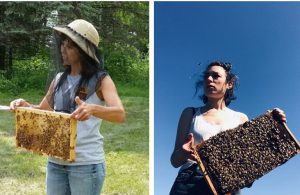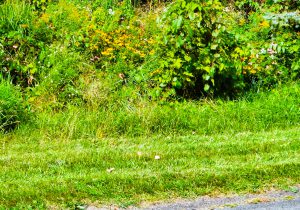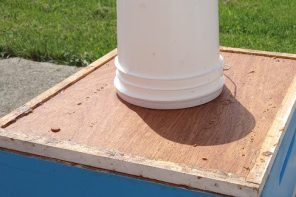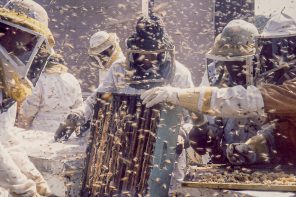
Becky Masterman led the UMN Bee Squad
from 2013-2019. Bridget Mendel joined the Bee Squad in 2013 and has led the program since 2020. Photos of Becky (left) and Bridget (right) looking for their respective hives. Please share any thoughts about roadside and ditch flowers or your beekeeping superstitions via email to
mindingyourbeesandcues@gmail.com
The Fascinating World of Ditch Management
By: Becky Masterman & Bridget Mendel
Do you remember Ms. Rumphius, the children’s book by Barbara Cooney? In it, a little girl in Maine is charged by her grandfather to do something to make the world a more beautiful place. Spoiler alert: what she ends up doing is scattering lupine seeds all over her neighborhood, beside roads, in ditches and on hillsides. She becomes known as “that crazy old lady” who rides her bike around the neighborhood throwing handfuls of seeds. In the Spring, the whole town is covered with beautiful blue and purple and rose colored lupines.
An even more popular seed thrower is the legendary Johnny Appleseed (https://en.wikipedia.org/wiki/Johnny_Appleseed), who in folklore traipsed across the country slinging apple seeds (and wearing a tin pot on his head). The real man behind the legend, John Chapman, did in fact plant apples in the early 1800’s, but not strictly helter-skelter. He planted and tended nurseries, introducing apples across North America.
He also apparently sowed dog fennel seeds (Eupatorium capillifolium), which are now considered a noxious invasive weed in some parts of the country.

Roadside managed by the Minnesota Department of Transportation. While this strip of land is not planted specifically for pollinators, when nutritional opportunities emerge, bees find them.
Photo Credit: Rebecca Masterman
Which brings us to our thesis: roadsides and the plants that grow in them are complicated; attempts to improve them are usually imperfect and will make someone mad; but efforts are still worth making because they will make a bee happy.
We all know that planting seeds is the number one action we need to take to help pollinators. Because we don’t all have the same access to land on which to put those seeds, planting gets perplexing. Public or publicly-used lands become of interest for many of us, as a significant acreage of potentially pollinator-friendly geography. But of course, not everyone has the same goals when planting for pollinators.
Johnny’s invasive dog fennel has an equivalent in the aggressively-cheery yellow colored birdsfoot trefoil, loved by honey bees but despised by native plant ecologists. Articles such as this one (https://www.honeybeesuite.com/what-is-ethical-beekeeping/) dig (with questionable success) into the ethics of beekeepers throwing clover seed along roadsides that subsequently may require more maintenance (and taxpayer dollars) to control their spread. Since honey bees need food, beekeepers are primo candidates to engage with the roadside authorities-that-be to find ways to add flowers to management plans.

This roadside is planted for pollinators and managed for sight lines.
Photo Credit: Rebecca Masterman
Now and again, one sees a berm of goldenrod or a length of purple asters or joe-pye-weed along a highway, but it’s certainly not consistent. Many competing factors go into roadside management, such as the need for clear sight lines for drivers, and safe spaces to pull over along the roadways. Roadside managers juggle competing (but potentially complementary) environmental concerns as well: erosion control, stormwater management, invasive weed control, and pest control.
Traffic is of course, dangerous for all living things that collide with it, so attracting birds, butterflies and bees to busy roadsides is a double edged sword. In our northern climates, salt, used on ice and snow in Winter, also has an impact on the adjacent habitat. In a fascinating paper (https://www.pnas.org/doi/10.1073/pnas.1323607111) researcher Emily Snell-Rood discusses the impact that high levels of sodium have on trait selection in monarch and cabbage white butterflies: while there are positive effects for butterflies reared on sodium-rich roadside milkweed, their survivorship levels are significantly lower than non-roadside-reared butterflies.
Your brain brimming with knowledge about the perils of roadside plantings, you might be tempted to give up. But bees can’t be choosy these days, and need every inch of habitat they can get, and roadsides, by definition connective, can help create corridors of connective (if imperfect) habitat.
In our state, the Minnesota Department of Transportation directly manages about 10% of roadways, equaling about 175,000 acres of greenspace along 12,000 miles of Interstate, State and U.S. Highways. One method they use to increase pollinator (and bird) habitat on roadways is to engage external partners: communities can “adopt” a roadway and help to maintain it (https://www.dnr.state.mn.us/roadsidesforwildlife/index.html) or “sponsor” a roadway and fund restoration and maintenance efforts (https://www.dot.state.mn.us/highway-sponsorship/about.html). Why not ask Siri who your local road authorities are, and what they are doing to promote habitat when possible? Then ask yourself what you can do to make your highways more habitable—and the world a more beautiful place.
Acknowledgement
The authors would like to thank Dr. Marla Spivak for helpful edits and suggestions.








